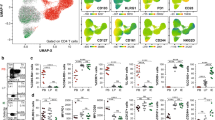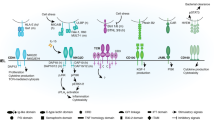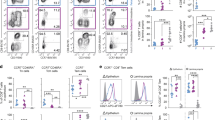Abstract
One unresolved issue in gut immunity is how mucosal T lymphocytes are activated and which antigen-presenting cell (APC) is critical for the regulation of this process. We have identified a unique population of APCs that is exclusively localized in the lamina propria. These APCs constitutively expressed the costimulatory molecule CD70 and had antigen-presenting functions. After oral infection of mice with Listeria monocytogenes, proliferation and differentiation of antigen-specific T cells occurred in the gut mucosa in situ and blockade of CD70 costimulation abrogated the mucosal T cell proliferation and effector functions. Thus, a potent CD70-dependent stimulation via specialized tissue-specific APCs is required for the proliferation and differentiation of gut mucosal T cells after oral infection.
This is a preview of subscription content, access via your institution
Access options
Subscribe to this journal
Receive 12 print issues and online access
$209.00 per year
only $17.42 per issue
Buy this article
- Purchase on Springer Link
- Instant access to full article PDF
Prices may be subject to local taxes which are calculated during checkout






Similar content being viewed by others
References
Klein, J.R. Ontogeny of the Thy-1−, Lyt-2+ murine intestinal intraepithelial lymphocyte. Characterization of a unique population of thymus-independent cytotoxic effector cells in the intestinal mucosa. J. Exp. Med. 164, 309–314 (1986).
Huleatt, J.W. & Lefrancois, L. Antigen-driven induction of CD11c on intestinal intraepithelial lymphocytes and CD8+ T cells in vivo. J. Immunol. 154, 5684–5693 (1995).
Beagley, K.W. & Husband, A.J. Intraepithelial lymphocytes: origins, distribution, and function. Crit. Rev. Immunol. 18, 237–254 (1998).
Goodman, T. & Lefrancois, L. Intraepithelial lymphocytes. Anatomical site, not T cell receptor form, dictates phenotype and function. J. Exp. Med. 170, 1569–1581 (1989).
Pirzer, U.C., Schurmann, G., Post, S., Betzler, M. & Meuer, S.C. Differential responsiveness to CD3-Ti vs. CD2-dependent activation of human intestinal T lymphocytes. Eur. J. Immunol. 20, 2339–2342 (1990).
Targan, S.R., Deem, R.L., Liu, M., Wang, S. & Nel, A. Definition of a lamina propria T cell responsive state. Enhanced cytokine responsiveness of T cells stimulated through the CD2 pathway. J. Immunol. 154, 664–675 (1995).
Zhou, Z., Pollok, K.E., Kim, K.K., Kim, Y.J. & Kwon, B.S. Functional analysis of T-cell antigen 4–1BB in activated intestinal intra-epithelial T lymphocytes. Immunol. Lett. 41, 177–184 (1994).
Wang, H.C. & Klein, J.R. Multiple levels of activation of murine CD8+ intraepithelial lymphocytes defined by OX40 (CD134) expression: effects on cell-mediated cytotoxicity, IFN-γ, and IL-10 regulation. J. Immunol. 167, 6717–6723 (2001).
Kim, S.K., Schluns, K.S. & Lefrancois, L. Induction and visualization of mucosal memory CD8 T cells following systemic virus infection. J. Immunol. 163, 4125–4132 (1999).
Kim, S.K. et al. Generation of mucosal cytotoxic T cells against soluble protein by tissue-specific environmental and costimulatory signals. Proc. Natl. Acad. Sci. USA 95, 10814–10819 (1998).
Gonsky, R. et al. Mucosa-specific targets for regulation of IFN-γ expression: lamina propria T cells use different cis-elements than peripheral blood T cells to regulate transactivation of IFN-γ expression. J. Immunol. 164, 1399–1407 (2000).
Huang, F.P. et al. A discrete subpopulation of dendritic cells transports apoptotic intestinal epithelial cells to T cell areas of mesenteric lymph nodes. J. Exp. Med. 191, 435–444 (2000).
Iwasaki, A. & Kelsall, B.L. Localization of distinct Peyer's patch dendritic cell subsets and their recruitment by chemokines macrophage inflammatory protein (MIP)-3α, MIP-3β, and secondary lymphoid organ chemokine. J. Exp. Med. 191, 1381–1394 (2000).
Mowat, A.M. Anatomical basis of tolerance and immunity to intestinal antigens. Nat. Rev. Immunol. 3, 331–341 (2003).
Castellaneta, A., Abe, M., Morelli, A.E. & Thomson, A.W. Identification and characterization of intestinal Peyer's patch interferon-α producing (plasmacytoid) dendritic cells. Hum. Immunol. 65, 104–113 (2004).
Bilsborough, J., George, T.C., Norment, A. & Viney, J.L. Mucosal CD8α+ DC, with a plasmacytoid phenotype, induce differentiation and support function of T cells with regulatory properties. Immunology 108, 481–492 (2003).
Iwasaki, A. & Kelsall, B.L. Freshly isolated Peyer's patch, but not spleen, dendritic cells produce interleukin 10 and induce the differentiation of T helper type 2 cells. J. Exp. Med. 190, 229–239 (1999).
Williamson, E., Bilsborough, J.M. & Viney, J.L. Regulation of mucosal dendritic cell function by receptor activator of NF-κB (RANK)/RANK ligand interactions: impact on tolerance induction. J. Immunol. 169, 3606–3612 (2002).
Martin, P. et al. Characterization of a new subpopulation of mouse CD8α+ B220+ dendritic cells endowed with type 1 interferon production capacity and tolerogenic potential. Blood 100, 383–390 (2002).
Futagawa, T. et al. Expression and function of 4–1BB and 4–1BB ligand on murine dendritic cells. Int. Immunol. 14, 275–286 (2002).
Akiba, H. et al. Critical contribution of OX40 ligand to T helper cell type 2 differentiation in experimental leishmaniasis. J. Exp. Med. 191, 375–380 (2000).
Arens, R. et al. Constitutive CD27/CD70 interaction induces expansion of effector-type T cells and results in IFNγ-mediated B cell depletion. Immunity 15, 801–812 (2001).
Tesselaar, K. et al. Lethal T cell immunodeficiency induced by chronic costimulation via CD27–CD70 interactions. Nat. Immunol. 4, 49–54 (2003).
Tesselaar, K. et al. Expression of the murine CD27 ligand CD70 in vitro and in vivo. J. Immunol. 170, 33–40 (2003).
Le, A.X. et al. Cytotoxic T cell responses in HLA-A2.1 transgenic mice. Recognition of HLA alloantigens and utilization of HLA-A2.1 as a restriction element. J. Immunol. 142, 1366–1371 (1989).
Powell, D.W. et al. Myofibroblasts. I. Paracrine cells important in health and disease. Am. J. Physiol. 277, C1–C9 (1999).
Thompson, R.J., Bouwer, H.G., Portnoy, D.A. & Frankel, F.R. Pathogenicity and immunogenicity of a Listeria monocytogenes strain that requires D-alanine for growth. Infect. Immun. 66, 3552–3561 (1998).
Manjunath, N. et al. A transgenic mouse model to analyze CD8+ effector T cell differentiation in vivo. Proc. Natl. Acad. Sci. USA 96, 13932–13937 (1999).
Manjunath, N. et al. Effector differentiation is not prerequisite for generation of memory cytotoxic T lymphocytes. J. Clin. Invest. 108, 871–878 (2001).
Kim, S.K., Reed, D.S., Heath, W.R., Carbone, F. & Lefrancois, L. Activation and migration of CD8 T cells in the intestinal mucosa. J. Immunol. 159, 4295–4306 (1997).
Vezys, V., Olson, S. & Lefrancois, L. Expression of intestine-specific antigen reveals novel pathways of CD8 T cell tolerance induction. Immunity 12, 505–514 (2000).
De Togni, P. et al. Abnormal development of peripheral lymphoid organs in mice deficient in lymphotoxin. Science 264, 703–707 (1994).
Kang, H.S. et al. Signaling via LTβR on the lamina propria stromal cells of the gut is required for IgA production. Nat. Immunol. 3, 576–582 (2002).
Newberry, R.D., McDonough, J.S., McDonald, K.G. & Lorenz, R.G. Postgestational lymphotoxin/lymphotoxin β receptor interactions are essential for the presence of intestinal B lymphocytes. J. Immunol. 168, 4988–4997 (2002).
Geginat, G., Schenk, S., Skoberne, M., Goebel, W. & Hof, H. A novel approach of direct ex vivo epitope mapping identifies dominant and subdominant CD4 and CD8 T cell epitopes from Listeria monocytogenes. J. Immunol. 166, 1877–1884 (2001).
Marco, A.J. et al. Penetration of Listeria monocytogenes in mice infected by the oral route. Microb. Pathog. 23, 255–263 (1997).
Shortman, K. & Liu, Y.J. Mouse and human dendritic cell subtypes. Nat. Rev. Immunol. 2, 151–161 (2002).
Ardavin, C. Origin, precursors and differentiation of mouse dendritic cells. Nat. Rev. Immunol. 3, 582–590 (2003).
Wilson, H.L. & O'Neill, H.C. Murine dendritic cell development: difficulties associated with subset analysis. Immunol. Cell Biol. 81, 239–246 (2003).
MacDonald, T.T. Effector and regulatory lymphoid cells and cytokines in mucosal sites. Curr. Top. Microbiol. Immunol. 236, 113–135 (1999).
Shires, J., Theodoridis, E. & Hayday, A.C. Biological insights into TCRγδ+ and TCRαβ+ intraepithelial lymphocytes provided by serial analysis of gene expression (SAGE). Immunity 15, 419–434 (2001).
Hayday, A., Theodoridis, E., Ramsburg, E. & Shires, J. Intraepithelial lymphocytes: exploring the Third Way in immunology. Nat. Immunol. 2, 997–1003 (2001).
Pope, C. et al. Organ-specific regulation of the CD8 T cell response to Listeria monocytogenes infection. J. Immunol. 166, 3402–3409 (2001).
Offit, P.A., Cunningham, S.L. & Dudzik, K.I. Memory and distribution of virus-specific cytotoxic T lymphocytes (CTLs) and CTL precursors after rotavirus infection. J. Virol. 65, 1318–1324 (1991).
Belyakov, I.M. et al. Mucosal immunization with HIV-1 peptide vaccine induces mucosal and systemic cytotoxic T lymphocytes and protective immunity in mice against intrarectal recombinant HIV-vaccinia challenge. Proc. Natl. Acad. Sci. USA 95, 1709–1714 (1998).
Masopust, D., Jiang, J., Shen, H. & Lefrancois, L. Direct analysis of the dynamics of the intestinal mucosa CD8 T cell response to systemic virus infection. J. Immunol. 166, 2348–2356 (2001).
Regnault, A., Cumano, A., Vassalli, P., Guy-Grand, D. & Kourilsky, P. Oligoclonal repertoire of the CD8αα and the CD8αβ TCR-α/β murine intestinal intraepithelial T lymphocytes: evidence for the random emergence of T cells. J. Exp. Med. 180, 1345–1358 (1994).
Arstila, T. et al. Identical T cell clones are located within the mouse gut epithelium and lamina propia and circulate in the thoracic duct lymph. J. Exp. Med. 191, 823–834 (2000).
Yamamoto, M. et al. Alternate mucosal immune system: organized Peyer's patches are not required for IgA responses in the gastrointestinal tract. J. Immunol. 164, 5184–5191 (2000).
Spahn, T.W. et al. Induction of oral tolerance to cellular immune responses in the absence of Peyer's patches. Eur. J. Immunol. 31, 1278–1287 (2001).
Banks, T.A. et al. Lymphotoxin-α-deficient mice. Effects on secondary lymphoid organ development and humoral immune responsiveness. J. Immunol. 155, 1685–1693 (1995).
Davis, I.A., Knight, K.A. & Rouse, B.T. The spleen and organized lymph nodes are not essential for the development of gut-induced mucosal immune responses in lymphotoxin-α deficient mice. Clin. Immunol. Immunopathol. 89, 150–159 (1998).
Futterer, A., Mink, K., Luz, A., Kosco-Vilbois, M.H. & Pfeffer, K. The lymphotoxin beta receptor controls organogenesis and affinity maturation in peripheral lymphoid tissues. Immunity 9, 59–70 (1998).
Eugster, H.P. et al. Multiple immune abnormalities in tumor necrosis factor and lymphotoxin-α double-deficient mice. Int. Immunol. 8, 23–36 (1996).
Pircher, H., Burki, K., Lang, R., Hengartner, H. & Zinkernagel, R.M. Tolerance induction in double specific T-cell receptor transgenic mice varies with antigen. Nature 342, 559–561 (1989).
Lefrancois, L. & Lycke, N. in Current Protocols in Immunology (ed. Caico, R.) 3.19.1–16 (John Wiley & Sons, New York, 1996).
Meyer, A.L. et al. Rapid depletion of peripheral antigen-specific T cells in TCR-transgenic mice after oral administration of myelin basic protein. J. Immunol. 166, 5773–5781 (2001).
Acknowledgements
We thank A. Schlesinger for help with ELISPOT assays. Supported by the US National Institutes of Health (AI46566 to N.M.).
Author information
Authors and Affiliations
Corresponding author
Ethics declarations
Competing interests
The authors declare no competing financial interests.
Supplementary information
Supplementary Fig. 1
Phenotype and morphology of CD70+ APC and their presence in MuMT and RAG-1−/− mice. (PDF 226 kb)
Supplementary Fig. 2
Purity of cell preparations and capture of Lm by CD70+ APC. (PDF 369 kb)
Supplementary Fig. 3
CD70 blockade selectively inhibits mucosal T cell expansion. (PDF 156 kb)
Rights and permissions
About this article
Cite this article
Laouar, A., Haridas, V., Vargas, D. et al. CD70+ antigen-presenting cells control the proliferation and differentiation of T cells in the intestinal mucosa. Nat Immunol 6, 698–706 (2005). https://doi.org/10.1038/ni1212
Received:
Accepted:
Published:
Issue Date:
DOI: https://doi.org/10.1038/ni1212
This article is cited by
-
Regulation of human intestinal T-cell responses by type 1 interferon-STAT1 signaling is disrupted in inflammatory bowel disease
Mucosal Immunology (2017)
-
The CD4+ T-cell help signal is transmitted from APC to CD8+ T-cells via CD27–CD70 interactions
Nature Communications (2012)
-
Association of CD27 and CD70 gene polymorphisms with risk of sporadic breast cancer in Chinese women in Heilongjiang Province
Breast Cancer Research and Treatment (2012)
-
NKT cells in mucosal immunity
Mucosal Immunology (2009)
-
The role of TNF superfamily members in T-cell function and diseases
Nature Reviews Immunology (2009)



